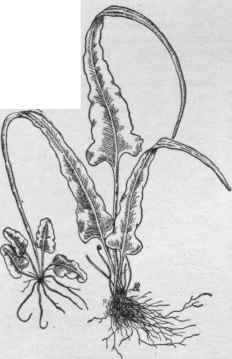Camphora - Caralluma
Description
This section is from the book "The Standard Cyclopedia Of Horticulture Vol2", by L. H. Bailey. See also: Western Garden Book: More than 8,000 Plants - The Right Plants for Your Climate - Tips from Western Garden Experts.
Camphora - Caralluma
Camphora
: Cinnamomum.
Campion
: Silene.
Camptosorus
(Greek, bent sori, alluding to the irregular arrangement). Polypodiaceae. Two species of hardy ferns, with simple pointed leaves, which take root at the apex, and are hence known as "walking-leaf ferns." A single species is native mostly on lime-bearing rocks, and an allied species is known from Japan and N. Asia.
Rhizophyllus
Link. Fig. 776. Leaves evergreen, simple, tapering from a heart-shaped base, 4-12 in. long; veins forming meshes near the midrib; sori irregularly scattered, linear, straight or bent. Canada to Ala. - Sometimes grown in rockeries and wild gardens. L. M. Underwood.

Fig. 776. Camptosorus rhizophyllus. (X 1/3)
Campylobotrys
: Hoffmannia.
Campyloneuron
: Polypodium.
Canada
: British North America.
Canaigre
: Rumex Hymenosepalus.
Cananga
: Canan-Gium.
Canarina
(from the Canary Islands). Campanu-laceae. Cool-house tuberous-rooted herb closely allied to Campanula, but with the tubes of the calyx and corolla grown together, and the floral parts in 6's. - Three species. C. Campanula, Lam., is a tender perennial from the Canaries, about 6-8 ft. tall, with drooping, inflated buds and solitary, bell-shaped flowers more than 1 in. long and 1 1/2 in. wide, dull yellow, flushed and veined with dull purplish brown: the lobes of the corolla strongly reflexed: leaves hastate, coarsely repand-dentate: fruit a fleshy berry. B.M. 444. - Intro, by Franceschi in 1895.
Canary-Bird Flower
: Tropaeolum.
Canary Grass
: Phalaris.
Candelillo
: Euphorbia Antisyphilitica
Candleberry, Candlenut
: Aleuriles.
Candytuft
: Iberis.
Cane-Brake
: Species Of Arundinaria (Treated Under Bamboo).
Canteloupe
: Muskmelon.
Canterbury Bell
: Campanula Medium.
Caoutchouc Tree
Hura, Manihot, Ficus elastica, Castilloa, Hevea, Landolphia, and others, not treated here.
Cape Bulbs
A name applied to bulbous and bulblike plants native to South Africa. They are dry-region plants, and often bloom with us in summer and autumn. Some of the leading genera are Amaryllis, Brunsvigia, Nerine, Ixia, Tritonia, Watsonia. See Bulbs.
Cape'Chestnut
: Calodendrum Capensis.
Cape Gooseberry
: Physalis
Cape Jessamine
: Gardenia
Caper
: Capparis
Cape-Spurge
: Euphorbia Lathyrus.
Caprifolium
: Lonicera.
Caprlola
: Cynodon.
Caraguata
By the latest monographer referred to Guz-mania, which see.
Caralluma
(aboriginal name). Asclepiadaceae. Low succulents, sometimes seen in collections; about 40 species, from S. Spain and Africa to Arabia and India. They resemble stapelias, and require similar treatment. The stems are leafless, somewhat branched, erect, 4-sided and the angles toothed: flowers near the summit of the stems, more or less clustered, purple, brown and yellow, and other colors; corolla rotate and 5-parted: fruit long and slender follicles. The carallumas are probably not in the American trade. Some of the names that may be expected in collections are C. adscendens, R. Br.; C. affinis, Wildem.; C. campanulata, N. E. Br. (Boucerosia campanulata, Wight); C. commutata, Berger (sometimes grown as C. Sprengeri); C. fimbri-ata, Wall.; C. inversa, N. E. Br.; C. Luntii, N. E. Br.;
C. Sprengeri, N. E. Br.; C. Simonis, Berger (Boucerosia Simonis, Hort.); C. torta, N. E. Br.
Continue to:


